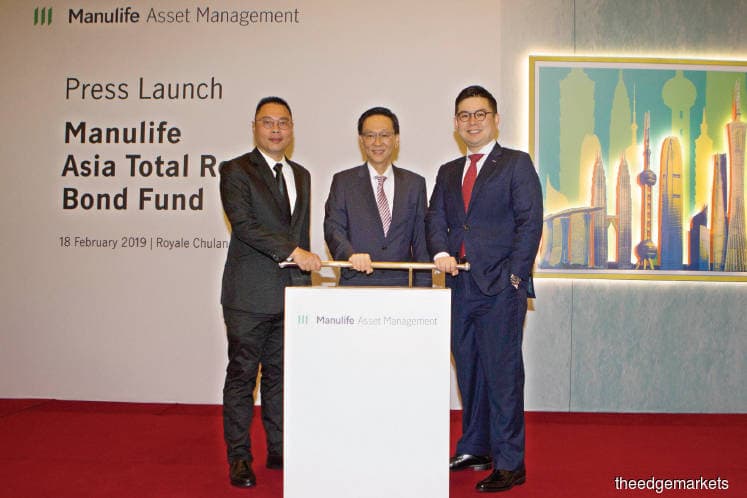
This article first appeared in The Edge Financial Daily on February 19, 2019
KUALA LUMPUR: The uncertainty in the financial markets and lower prospects of a US Federal Reserve (Fed) rate hike this year have whipped up an appetite for Asian bonds, says Manulife Asset Management Services Bhd (MAMSB).
“There is definitely an increase in demand for fixed income products,” said Ng Chze How, MAMSB’s head of retail wealth distribution.
Jason Pang, fixed income client portfolio manager at Manulife Asset Management in Hong Kong, said that with the markets now pricing in zero to one rate hike by the Fed, the money that has shied away from emerging markets last year is likely to return in 2019.
“Asian bonds are in a sweet spot due to attractive yields, high credit ratings and the potential appreciation in Asian currencies this year,” he said at the launch of Manulife’s Asia Total Return Bond Fund yesterday.
Compared to 10-year US Treasury bills, which offer a yield of 2.66% at the time of writing, Asian markets are posting twice to triple the yield. Indonesia currently outshines its peers by this measure — its 10-year government currently offers a yield of 8%.
Malaysian government securities are also considered relatively attractive in terms of yields, especially considering their high and relatively stable credit rating.
“There aren’t many countries around Asia that have a stable A credit rating, giving the 10-year Malaysian Government Securities around 4% (yield),” Pang pointed out.
Meanwhile, considering the stabilisation of the Fed’s interest rate normalisation, the US dollar is also expected to have peaked, said Pang.
“We still expect one more rate hike this year, but whether or not there is one is not so important. What matters is that investors don’t see another (rate hike) after that,” he said, adding that this will be favourable for an appreciation in Asian currencies.
Ng opined that the ringgit could see an appreciation of as much as 5% this year based on that factor.
Other factors in support of funds returning to Asia are its high growth rate relative to other regions, low volatility and low expected default rates, Pang added.
He believes that a double-digit growth rate of return for Asian bonds is not an unlikely scenario this year.
“There are some pockets that are seeing high yield — if you have the right teams, pick the right bonds, then you can definitely hit the double-digit growth rate,” Pang said.
Yesterday, Bloomberg cited investors as saying that Asia’s US dollar-denominated bond market could record up to 10% returns this year on expectations of policy easing in the US and China.
The report pointed out that the asset class has already made its strongest start of 2.4% this year since 2012.
Ng is therefore confident that Manulife’s Asia Total Return Bond Fund, which will invest 95% of its net asset value in Hong Kong-managed Manulife Global Fund — Asia Total Return Fund — will be able to secure RM100 million from investors in “one to three months”.
Jason Chong, chief executive officer of MAMSB, said customers in Malaysia are looking for steady income returns and potential capital appreciation without too much volatility.
“This is something that our strategy offers,” he told reporters.